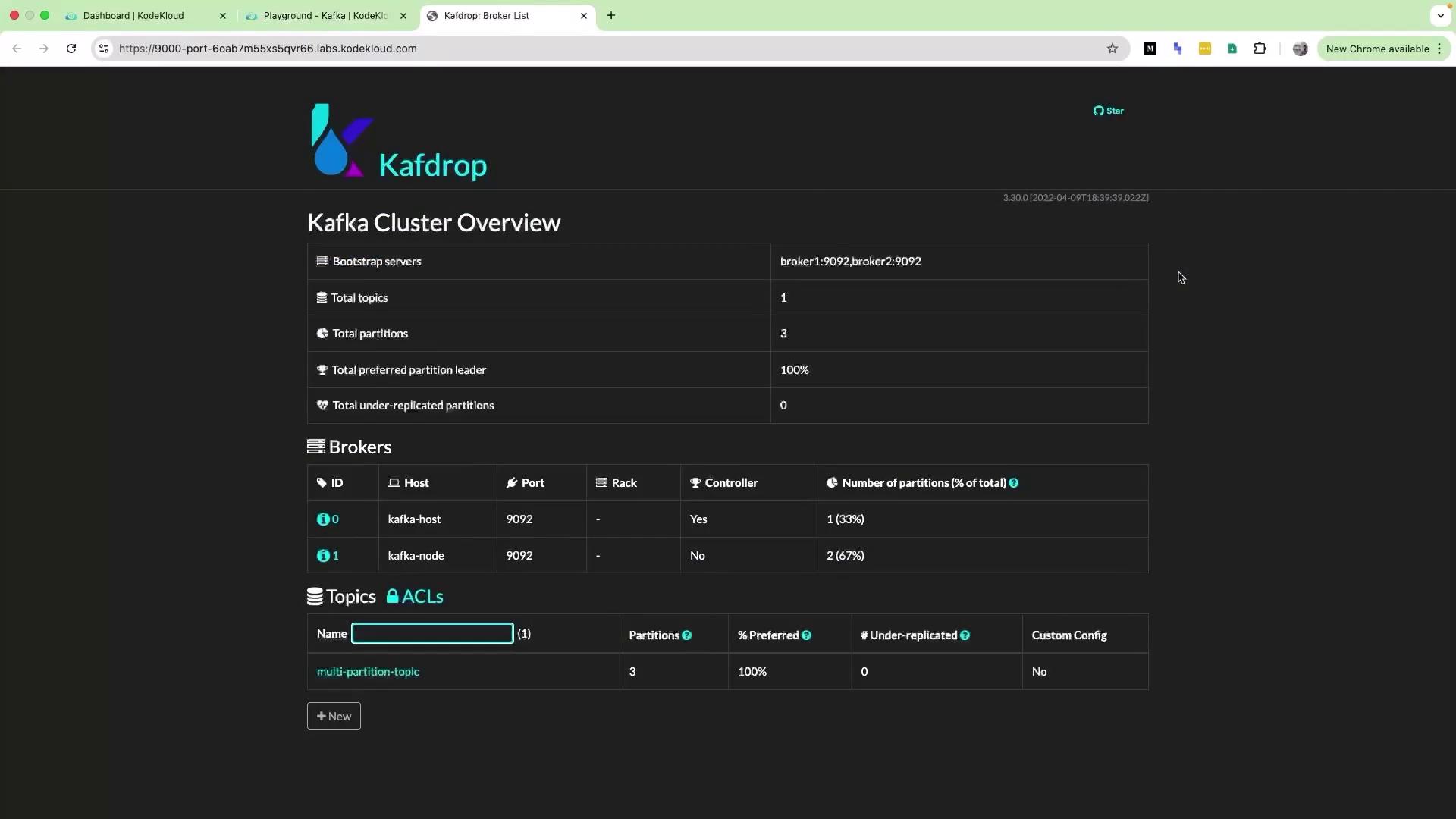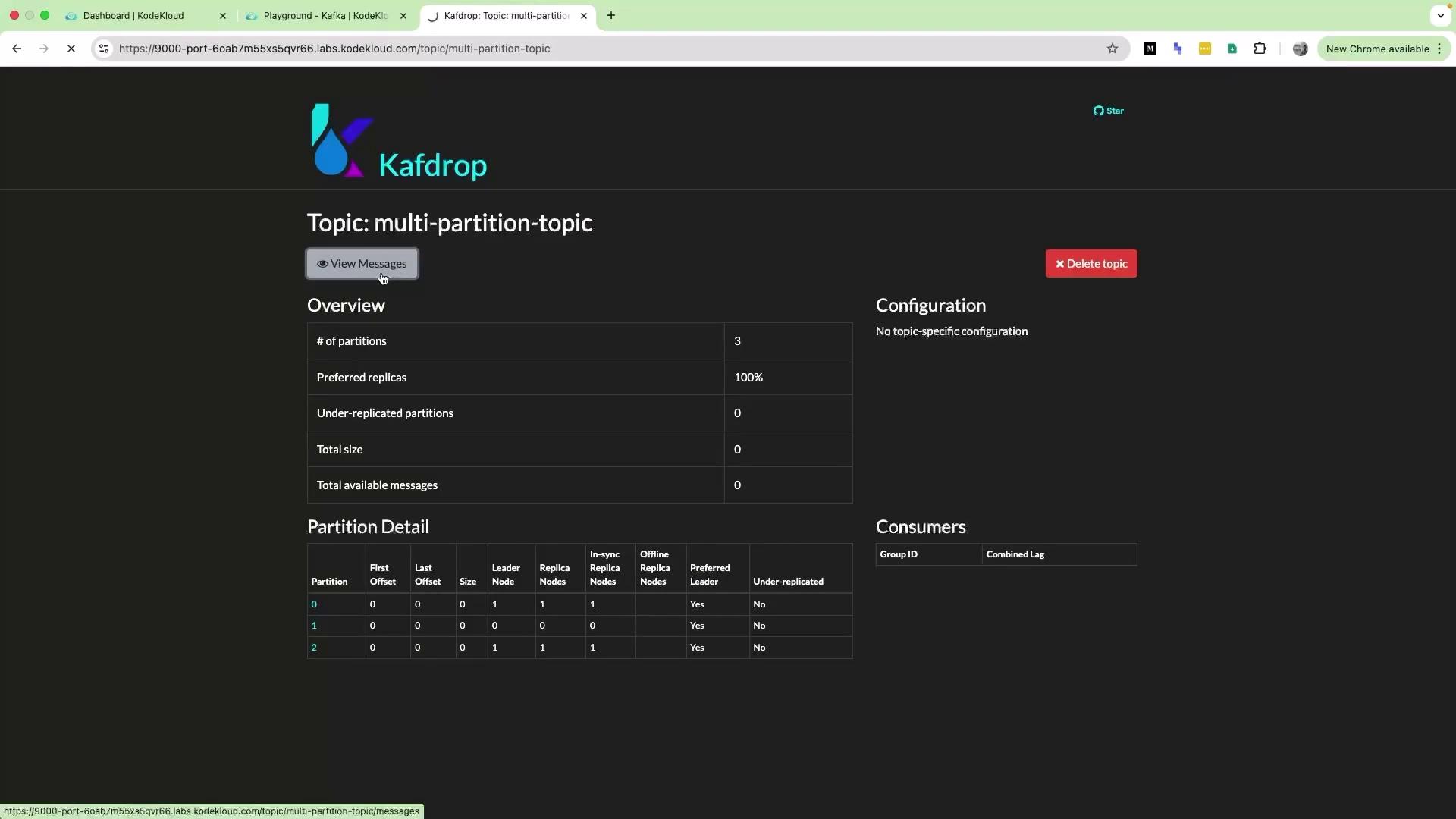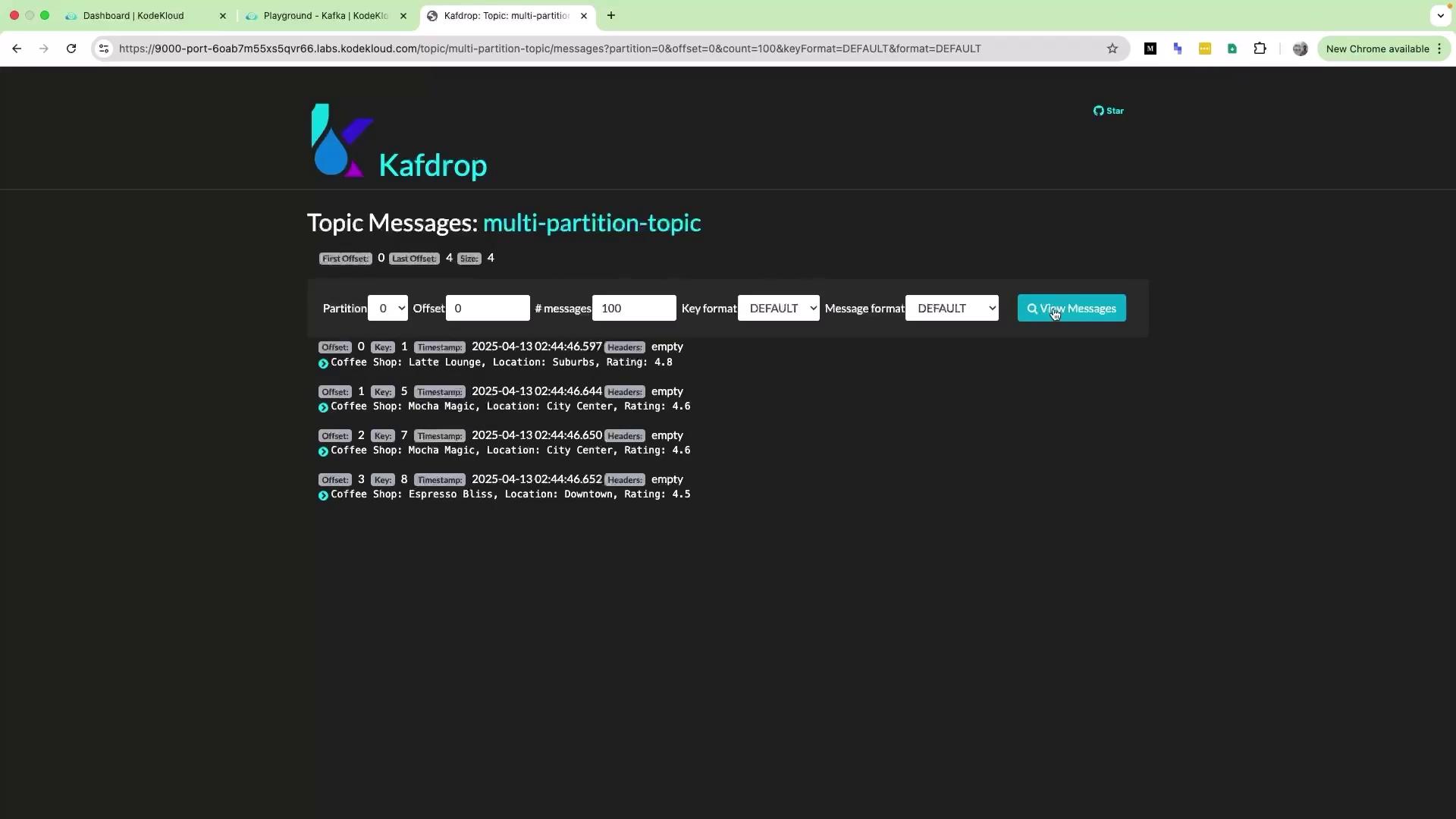Event Streaming with Kafka
Kafka Producers Consumers The Message Flow
Demo Kafka Producers
In this lesson, you’ll learn how to configure a Kafka producer with Python, create a multi-partition topic, and verify message distribution using Kafdrop. We’ll cover:
- Lab environment setup
- Creating a Kafka topic with 3 partitions
- Writing a Python producer to send sample events
- Validating messages across partitions
Lab Setup
Assuming Apache Kafka is already running, switch to the Kafka installation directory and inspect its contents:
root@kafka-host:~$ cd /root/kafka/
root@kafka-host:~/kafka$ ls -lrt
total 96
-rw-r--r-- 1 root root 28184 Sep 13 2022 NOTICE
-rw-r--r-- 1 root root 14640 Sep 13 2022 LICENSE
drwxr-xr-x 3 root root 4096 Sep 13 2022 config
drwxr-xr-x 3 root root 4096 Sep 13 2022 bin
drwxr-xr-x 2 root root 4096 Sep 13 2022 site-docs
drwxr-xr-x 2 root root 4096 Feb 8 2023 libs
drwxr-xr-x 2 root root 4096 Apr 13 02:26 logs
-rw-r--r-- 1 root root 26117 Apr 13 02:26 kafka.log
The bin/ directory contains Kafka’s command-line tools:
| CLI Tool | Description | Example Usage |
|---|---|---|
| kafka-topics.sh | Manage topics | ./kafka-topics.sh --list ... |
| kafka-console-producer.sh | Produce messages interactively | ./kafka-console-producer.sh ... |
| kafka-console-consumer.sh | Consume messages interactively | ./kafka-console-consumer.sh ... |
root@kafka-host:~/kafka$ cd bin/
root@kafka-host:~/kafka/bin$ ls
kafka-topics.sh kafka-console-producer.sh kafka-console-consumer.sh ...
Creating a Multi-Partition Topic
Use kafka-topics.sh to create multi-partition-topic with 3 partitions and a replication factor of 1:
root@kafka-host:~/kafka/bin$ \
./kafka-topics.sh \
--create \
--topic multi-partition-topic \
--bootstrap-server localhost:9092 \
--partitions 3 \
--replication-factor 1
Warning
In production, use an appropriate replication factor (≥2) for fault tolerance.
After creation, verify the topic in Kafdrop’s cluster overview:

Inspect partition distribution and consumer group info:

No messages appear yet—let’s produce some events.
Producing Messages with Python
First, install Python dependencies in a virtual environment:
root@kafka-host:~/kafka/bin$ sudo apt update
root@kafka-host:~/kafka/bin$ python3 -m venv kafka-env
root@kafka-host:~/kafka/bin$ source kafka-env/bin/activate
(kafka-env) root@kafka-host:~/kafka/bin$ pip install kafka-python
Note
Using a virtual environment isolates dependencies and avoids system-wide changes.
Create kafka_producer_example.py with the following content:
import random
import logging
from kafka import KafkaProducer
# Configure logging
logging.basicConfig(
level=logging.INFO,
format="%(asctime)s - %(levelname)s - %(message)s"
)
# Initialize Kafka producer
producer = KafkaProducer(bootstrap_servers='localhost:9092')
# Sample coffee shop data
coffee_shops = [
{"name": "Espresso Bliss", "location": "Downtown", "rating": 4.5},
{"name": "Cappuccino Corner", "location": "Uptown", "rating": 4.2},
{"name": "Latte Lounge", "location": "Suburbs", "rating": 4.8},
{"name": "Mocha Magic", "location": "City Center", "rating": 4.6},
{"name": "Coffee Haven", "location": "East Side", "rating": 4.3},
]
# Send 10 messages to the topic
for i in range(10):
shop = random.choice(coffee_shops)
message = (
f"Coffee Shop: {shop['name']}, "
f"Location: {shop['location']}, "
f"Rating: {shop['rating']}"
)
try:
future = producer.send(
'multi-partition-topic',
key=str(i).encode('utf-8'),
value=message.encode('utf-8')
)
metadata = future.get(timeout=10)
logging.info(
f"Message {i} delivered to "
f"{metadata.topic}[{metadata.partition}]"
)
except Exception as e:
logging.error(f"Failed to deliver message {i}: {e}")
producer.flush()
logging.info("Finished sending messages")
Run the producer:
(kafka-env) root@kafka-host:~/kafka/bin$ python3 kafka_producer_example.py
You should see logs like:
2025-04-13 02:44:46,443 - INFO - <BrokerConnection client_id=bootstrap-0 host=localhost:9092 connecting>...
2025-04-13 02:44:46,551 - INFO - Message 0 delivered to multi-partition-topic[2]
...
2025-04-13 02:44:47,012 - INFO - Finished sending messages
Verifying Messages in Kafdrop
Use Kafdrop or the Kafka CLI consumer to confirm that 10 messages are spread across partitions 0, 1, and 2:

Switch between partition filters (0, 1, 2) to see parallel event distribution.
Conclusion
You’ve successfully:
- Created a Kafka topic with multiple partitions
- Built a Python producer to send sample events
- Validated message distribution across partitions
Next steps include exploring Kafka consumers, offset management, and advanced producer configurations.
References
Watch Video
Watch video content
Practice Lab
Practice lab